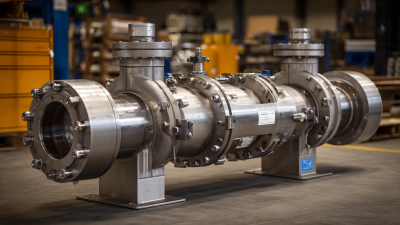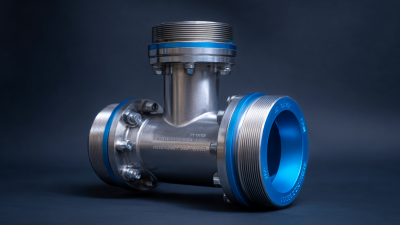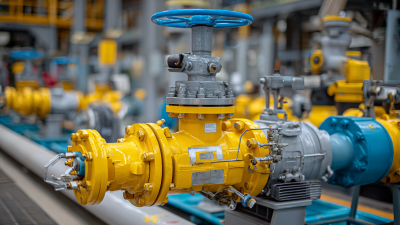Mastering Ball Valve Selection: A Comprehensive Tutorial for Optimal Flow Control in Industrial Applications
In the realm of industrial applications, the importance of selecting the right ball valve cannot be overstated. According to a recent report by MarketsandMarkets, the global ball valve market is expected to reach USD 10.67 billion by 2026, growing at a CAGR of 5.4% from 2021 to 2026. This growth underscores the critical role that ball valves play in ensuring optimal flow control, durability, and reliability across various sectors, including oil and gas, water treatment, and chemical processing. As industries increasingly prioritize efficiency and safety, mastering the nuances of ball valve selection becomes essential. This comprehensive tutorial aims to equip engineers and facility managers with the necessary knowledge and tools to make informed choices, ultimately enhancing flow management and operational effectiveness in their applications.

Understanding Ball Valve Types: A Review of 5 Common Variants for Industrial Use
When selecting the right ball valve for industrial applications, understanding the various types available is crucial. There are five common variants that stand out due to their specific functionalities and advantages: floating ball valves, trunnion-mounted ball valves, hand-operated ball valves, actuated ball valves, and multi-port ball valves. According to the latest Market Research Future report, the global ball valve market is projected to reach $13 billion by 2025, reflecting a compound annual growth rate (CAGR) of 6.6%. This growth highlights the increasing reliance on these valves across industries such as oil and gas, water and wastewater treatment, and chemical processing.
Floating ball valves are often favored for low to medium pressure applications, providing optimal sealing without complex designs. Trunnion-mounted ball valves, on the other hand, are ideal for high-pressure situations, offering lower torque and better stability. Actuated and multi-port valves enhance automation capabilities and streamline fluid control processes. In fact, a recent study from Global Industry Analysts emphasizes that the demand for automated valves is expected to surge, driven by advancements in smart technology and the increasing need for efficient operations. By understanding these common variants and their applications, industries can ensure they choose the best ball valve for their specific flow control needs.

The Role of Pressure Ratings: 3 Key Considerations for Ball Valve Selection
When selecting ball valves for industrial applications, understanding pressure ratings is crucial. Pressure ratings indicate the maximum pressure a valve can handle safely, impacting the choice of materials and design. Three key considerations should guide the selection process: the type of fluid being handled, the temperature of operation, and the potential for pressure surges. Each of these factors can significantly influence the valve's performance and longevity.
Firstly, the nature of the fluid—whether it is corrosive, viscous, or contains solids—affects the material selection for the ball valve. For instance, corrosive fluids require valves made of high-grade materials to withstand degradation, while viscous fluids might necessitate valves optimized for lower pressure drops. Secondly, temperature plays a vital role; elevated temperatures can reduce the mechanical strength of materials, thus requiring valves with appropriate pressure ratings to avoid failure. Lastly, pressure surges, which can occur in various industrial processes, must be anticipated. Selecting a valve with a pressure rating that can accommodate these surges provides added safety and reliability in operations. Overall, considering these three factors ensures effective flow control and enhances the operational lifespan of ball valves in demanding industrial settings.
Mastering Ball Valve Selection: A Comprehensive Tutorial for Optimal Flow Control in Industrial Applications
| Pressure Rating (PSI) | Temperature Range (°F) | Material Type | Application Type |
|---|---|---|---|
| 150 | -20 to 200 | PVC | Water Supply |
| 300 | 0 to 350 | Carbon Steel | Oil and Gas |
| 600 | -40 to 450 | Stainless Steel | Chemical Processing |
| 900 | -20 to 700 | Alloy Steel | High-Temperature Applications |
Flow Coefficients Explained: 4 Essential Metrics for Optimizing Flow Control
When it comes to selecting the right ball valve for industrial applications, understanding flow coefficients is crucial. Flow coefficients, often denoted as Cv values, are essential metrics that help determine how effectively a valve can control flow while minimizing resistance. The Cv value indicates the volume of fluid that can pass through the valve at a specified pressure drop, thus enabling engineers and operators to make informed decisions when tailoring systems for optimal performance.
There are four essential metrics to consider when evaluating flow coefficients: the size of the valve, the type of fluid, the pressure drop across the valve, and the desired flow rate. Each metric plays a vital role in establishing the valve's efficiency and reliability. For example, larger valves may offer higher Cv values, but if the fluid is viscous or if there's excessive pressure drop, the performance could be compromised. By analyzing these factors, industries can ensure that their flow control systems are not only functional but also capable of delivering precise and reliable results in various operational conditions.

Materials Matter: 5 Popular Materials for Durability and Performance in Ball Valves
When it comes to selecting ball valves for industrial applications, the choice of material is crucial for ensuring both durability and optimal performance. Among the most popular materials used in ball valve manufacturing are
stainless steel,
carbon steel,
plastic,
brass, and
bronze. Each of these materials offers distinct advantages that cater to specific operational requirements.
Stainless steel, known for its corrosion resistance and strength, is ideal for applications involving harsh chemicals and high temperatures.
Carbon steel, on the other hand, is often chosen for its cost-effectiveness and resilience in less corrosive environments. For applications that demand lightweight solutions, plastic ball valves offer excellent chemical resistance and low maintenance needs, making them suitable for water and certain acidic environments.
Brass ball valves are favored for their excellent machinability and corrosion resistance, especially in plumbing and heating applications.
Lastly, bronze provides great durability and is commonly used in marine environments due to its resistance to seawater corrosion.
Understanding the unique properties of these materials can greatly enhance the reliability and efficiency of ball valve performance in various industrial settings.
Installation Insights: 3 Best Practices for Effective Ball Valve Implementation in Industry
When it comes to installing ball valves in industrial applications, following best practices is essential to ensure optimal performance and longevity of the system. First and foremost, proper alignment during installation is crucial. Misalignment can lead to stress on the valve body, resulting in leaks or premature failure. Utilize alignment tools and double-check that the valve is positioned correctly relative to the piping before tightening any connections.
Secondly, consider the use of appropriate support systems. Heavy ball valves require adequate support to prevent sagging and bending of the pipelines. Installing support brackets or hangers can mitigate undue stress on the valve, ensuring smooth operation and reducing maintenance costs. Additionally, be sure to use the correct type of gaskets and sealants to prevent leaks at the joints. Choosing materials that are compatible with the process media will enhance the reliability of the installation.
Lastly, it is important to conduct a thorough inspection and testing after installation. Implement a pressure test to confirm that there are no leaks and that the valve operates as intended. Regular monitoring and maintenance routines can help identify any potential issues early, ensuring that the ball valve continues to perform effectively in your industrial processes. By adhering to these best practices, you can achieve a successful installation that enhances flow control and system efficiency.
Mastering Ball Valve Selection: Flow Control Performance Analysis
This chart illustrates the performance efficiency of different types of ball valves in various industrial applications. The data reflects flow rates measured in liters per minute (L/min) for each valve type under similar operating conditions.
Related Posts
-

Understanding the Benefits and Applications of Lockable Ball Valves in Industrial Settings
-

Unmatched Excellence in PTFE Lined Check Valves: Crafted in China, Delivered Worldwide
-

Understanding Industry Standards for the Best Actuator Valve and How to Choose the Right One
-

Mastering BFV Valves: A Comprehensive Tutorial on Selection, Sizing, and Optimization Techniques
